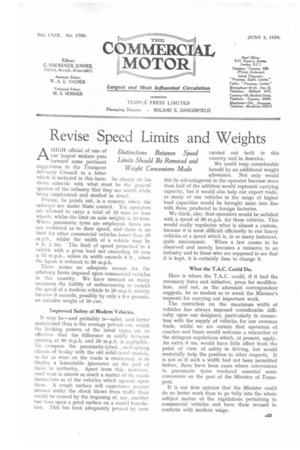Revise Speed Limits and Weights
Page 25

If you've noticed an error in this article please click here to report it so we can fix it.
AHIGH official of one of our largest makers puts forward some pertinent suggestions to the Transport Advisory Council in a letter which is included in this issue. So closely do his views coincide with what must be the general opinion of the industry that they arc worth while being emphasized and studied in detail.
France, he points out, is a country where the railways "are, under State control. Yet operators are allowed to carry a total of 19 tons on four wheels, whilst the limit on axle weights is 10 tons. Where pneumatic tyres are employed, buses are not restricted as to their speed, and there is no limit for other commercial vehicles lower than 28 m.p.h., whilst the width of a vehicle may be 8 ft. 2 ins. The limit of speed permitted to a vehicle with a gross load not exceeding 10 tons is 35 m.p.h., unless its width exceeds 8 ft., when the figure is reduced to 30 m.p.h. There seems no adequate reason for the arbitrary limits imposed upon commercial vehicles in this country. We have stressed on many occasions the futility of endeavouring to restrict the speed of a modern vehicle to 20 m.p.h. merely because it exceeds, possibly by only a few pounds, an unladen weight of 50 cwt.
Improved Safety of Modern Vehicles.
It may be—and probably is—safer, and better maintained than is the average private car, whilst the braking powers of the latest types are so effective that the difference in safety between running at 30 m.p.h. and 20 m.p.h. is negligible. To compare the pneumatic-tyred, . well-sprung chassis of to-day with the old solid-tyred models, so far as wear on the roads is concerned, is to display a lamentable ignorance on the part of those in authority. Apart from this, however, road wear is almost as much a matter of the roads themselves as of the vehicles which operate upon them. A rough surface will experience greater stresses under the shock blows from traffic than would be caused by the imposing of, say, another two tons upon a good surface on a sound foundation. This has been adequately proved by tests carried out both in this country and in America.
We could reap considerable benefit by an additional weight allowance. Not only would this be advantageous to the operator because more than half of the addition would represent carrying capacity, but it would also help our export trade, as many of our vehicles in the range of higher load capacities would be brought more into line with those produced in foreign factories.
We think, also, that operators would be satisfied with a speed of 30 m.p.h. for these vehicles. This would really regularize what is almost a custom, because it is most difficult efficiently to run heavy vehicles at a speed which is, in so many instances, quite uneconomic. When a law ceases to be observed and merely becomes a nuisance to an industry and to those who are supposed to see that it is kept, it is certainly time to change it.
What the T.A.C. Could Do.
Here is where the T.A.C. could, if it had the necessary force and initiative, press for modification, and not, as the aforesaid correspondent suggests, be so modest as to await the Minister's requests for carrying out important work.
The restriction on the maximum width of vehicles has .always imposed considerable difficulty upon our designers, particularly in connection with the supply of vehicles for our overseas trade, whilst we are certain that operators of coaches and buses would welcome a relaxation of the stringent regulations which, at present, apply. An extra 6 ins, would have little effect from the point of view of safety in driving, but would materially help the position in other respects. It is not as if such a width had not been permitted before, there have been cases where conversions to pneumatic tyres rendered essential some concession on the part of the Minister of Transport. It is our firm opinion that the Minister could do no better work than to go fully into the whole subject matter of the regulations pertaining to commercial vehicles and have these revised to conform with modern usage.












































































